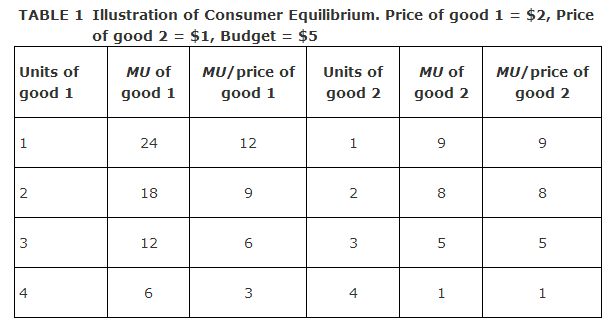When consumers make choices about the quantity of goods and services to consume, it is presumed that their objective is to maximize total utility. In maximizing total utility, the consumer faces a number of constraints, the most important of which are the consumer's income and the prices of the goods and services that the consumer wishes to consume. The consumer's effort to maximize total utility, subject to these constraints, is referred to as the consumer's problem. The solution to the consumer's problem, which entails decisions about how much the consumer will consume of a number of goods and services, is referred to as consumer equilibrium.
Determination of consumer equilibrium. Consider the simple case of a consumer who cares about consuming only two goods: good 1 and good 2. This consumer knows the prices of goods 1 and 2 and has a fixed income or budget that can be used to purchase quantities of goods 1 and 2. The consumer will purchase quantities of goods 1 and 2 so as to completely exhaust the budget for such purchases. The actual quantities purchased of each good are determined by the condition for consumer equilibrium, which is

This condition states that the marginal utility per dollar spent on good 1 must equal the marginal utility per dollar spent on good 2. If, for example, the marginal utility per dollar spent on good 1 were higher than the marginal utility per dollar spent on good 2, then it would make sense for the consumer to purchase more of good 1 rather than purchasing any more of good 2. After purchasing more and more of good 1, the marginal utility of good 1 will eventually fall due to the law of diminishing marginal utility, so that the marginal utility per dollar spent on good 1 will eventually equal that of good 2. Of course, the amount purchased of goods 1 and 2 cannot be limitless and will depend not only on the marginal utilities per dollar spent, but also on the consumer's budget.
An example. To illustrate how the consumer equilibrium condition determines the quantity of goods 1 and 2 that the consumer demands, suppose that the price of good 1 is $2 per unit and the price of good 2 is $1 per unit. Suppose also that the consumer has a budget of $5. The marginal utility ( MU) that the consumer receives from consuming 1 to 4 units of goods 1 and 2 is reported in Table . Here, marginal utility is measured in fictional units called utils, which serve to quantify the consumer's additional utility or satisfaction from consuming different quantities of goods 1 and 2. The larger the number of utils, the greater is the consumer's marginal utility from consuming that unit of the good. Table also reports the ratio of the consumer's marginal utility to the price of each good. For example, the consumer receives 24 utils from consuming the first unit of good 1, and the price of good 1 is $2. Hence, the ratio of the marginal utility of the first unit of good 1 to the price of good 1 is 12.

The consumer equilibrium is found by comparing the marginal utility per dollar spent (the ratio of the marginal utility to the price of a good) for goods 1 and 2, subject to the constraint that the consumer does not exceed her budget of $5. The marginal utility per dollar spent on the first unit of good 1 is greater than the marginal utility per dollar spent on the first unit of good 2(12 utils > 9 utils). Because the price of good 1 is $2 per unit, the consumer can afford to purchase this first unit of good 1, and so she does. She now has $5 − $2 = $3 remaining in her budget. The consumer's next step is to compare the marginal utility per dollar spent on the second unit of good 1 with marginal utility per dollar spent on the first unit of good 2. Because these ratios are both equal to 9 utils, the consumer is indifferent between purchasing the second unit of good 1 and first unit of good 2, so she purchases both. She can afford to do so because the second unit of good 1 costs $2 and the first unit of good 2 costs $1, for a total of $3. At this point, the consumer has exhausted her budget of $5 and has arrived at the consumer equilibrium, where the marginal utilities per dollar spent are equal. The consumer's equilibrium choice is to purchase 2 units of good 1 and 1 unit of good 2.
The condition for consumer equilibrium can be extended to the more realistic case where the consumer must choose how much to consume of many different goods. When there are N > 2 goods to choose from, the consumer equilibrium condition is to equate all of the marginal utilities per dollar spent,


![]()
subject to the constraint that the consumer's purchases do not exceed her budget.